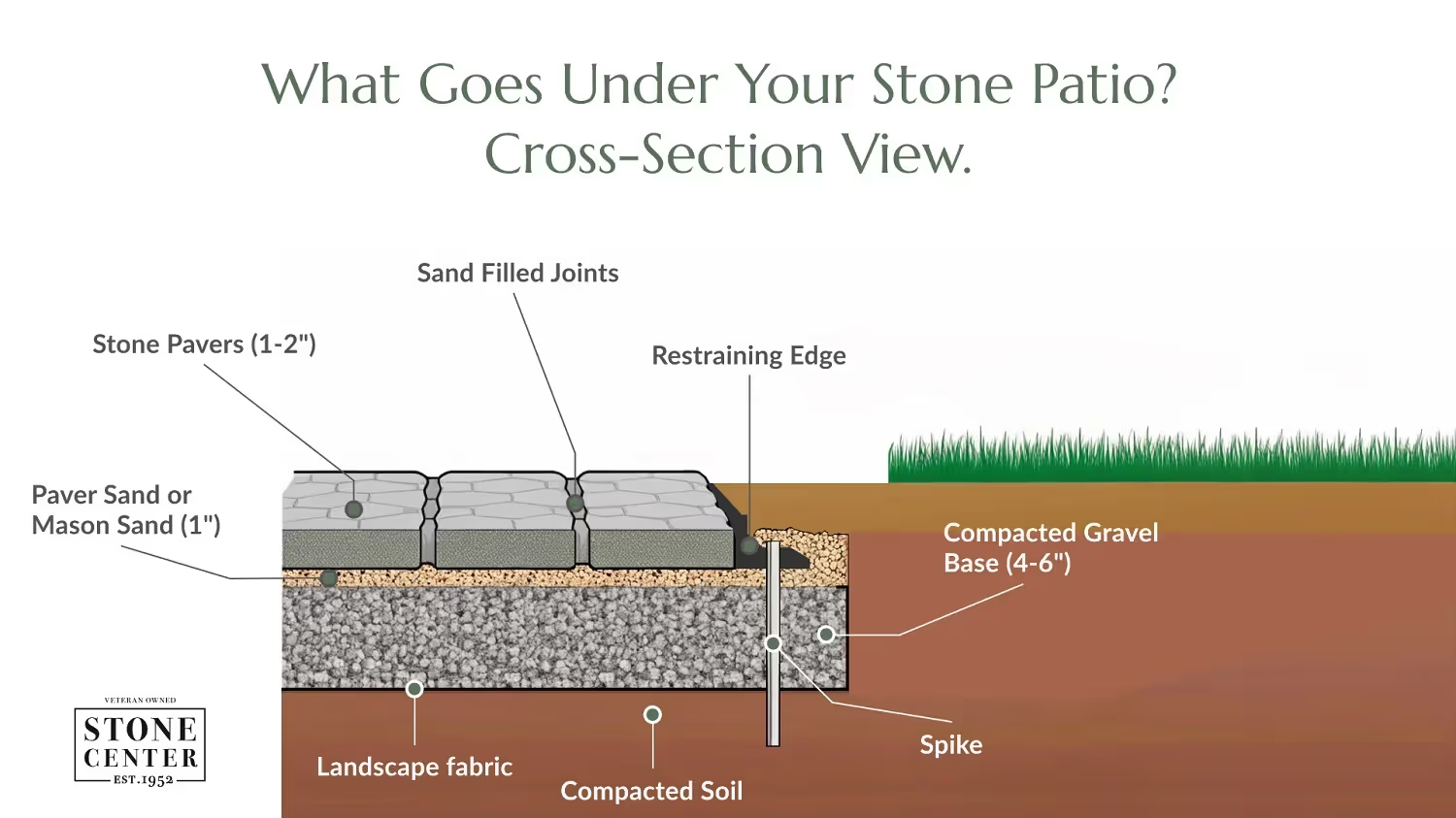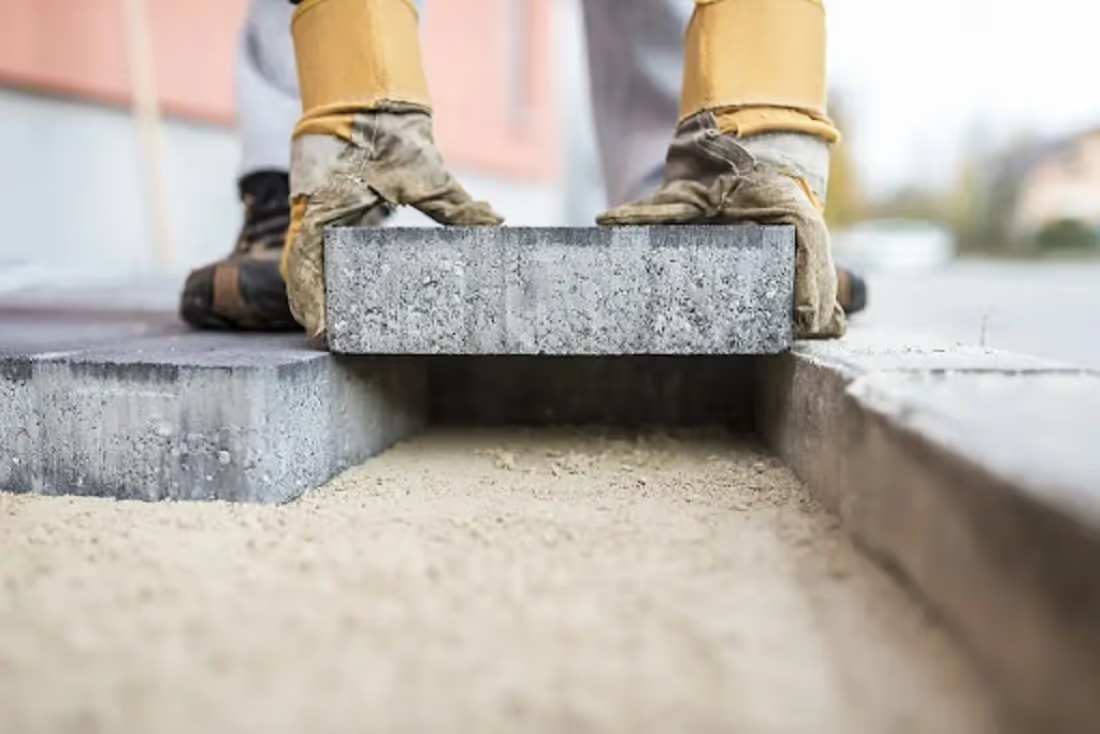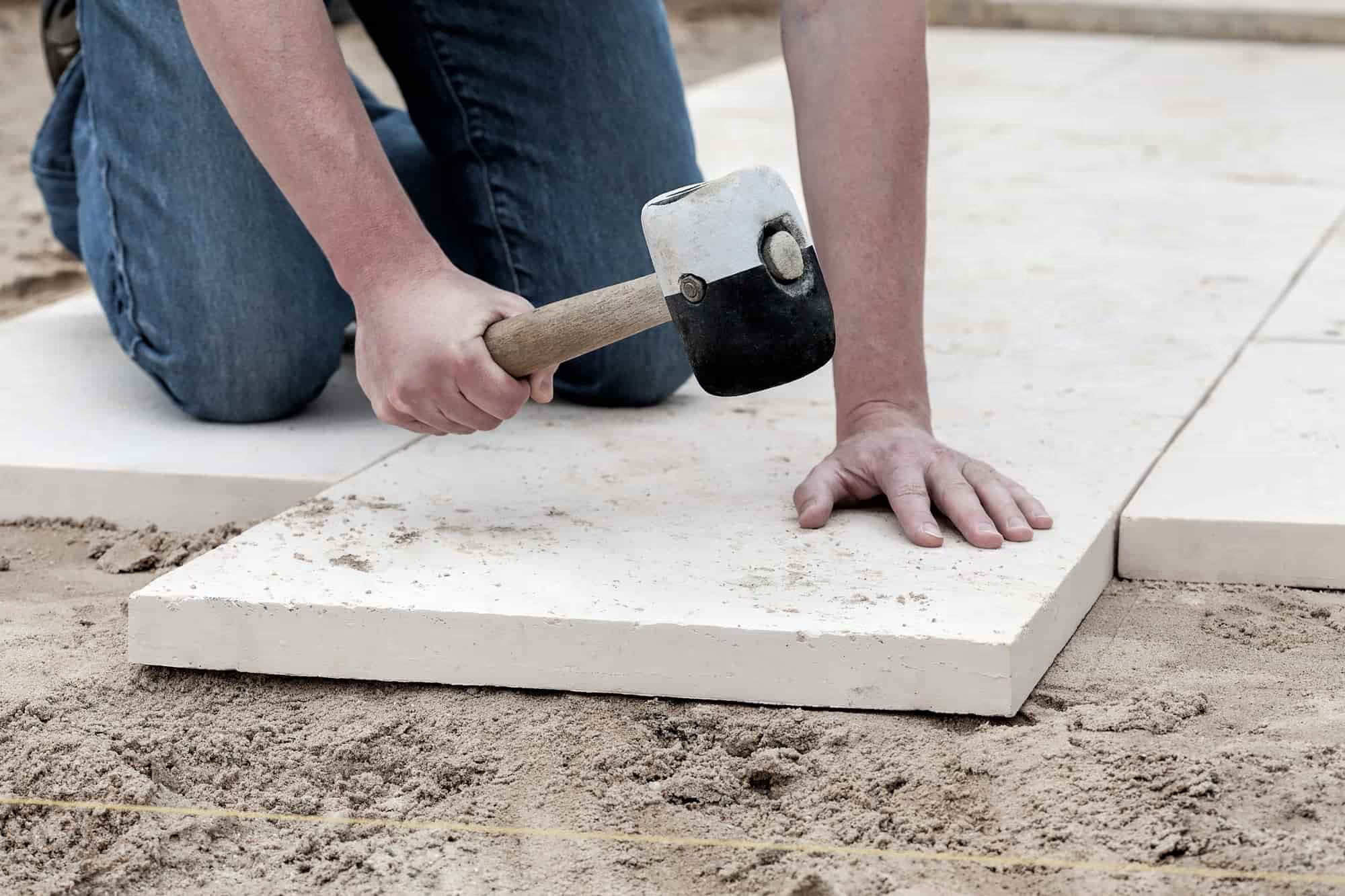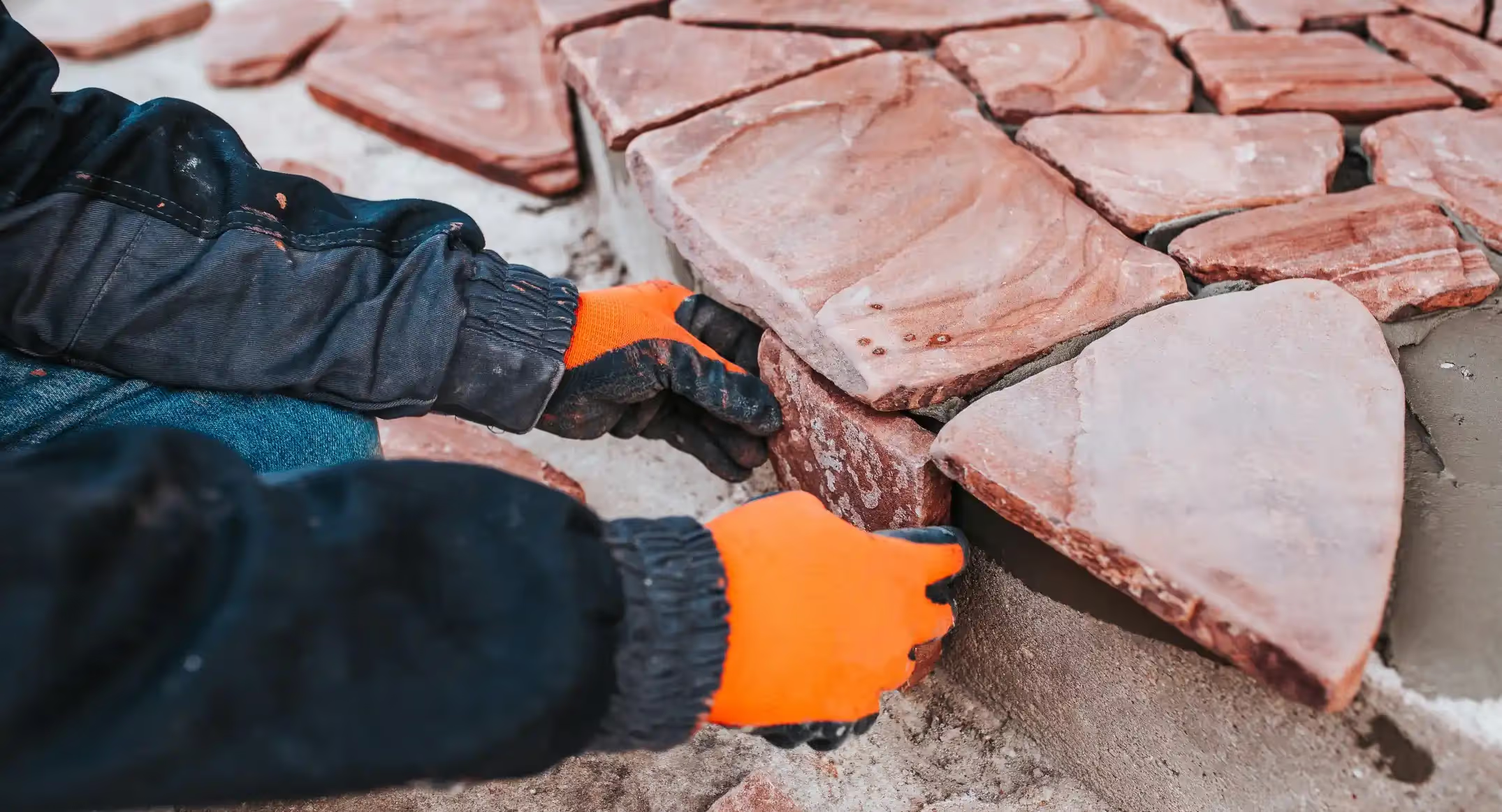- Stone Center
- Blog
How to Lay Stone Pavers for Patios, Driveways, and More
17/12/2025
4/24/2025
How to Lay Stone Pavers for Patios, Driveways, and More

Homeowners all across Columbus and Cincinnati have discovered the appeal of patio pavers. Flagstone, granite, bluestone, marble, travertine, and slate — these stones make ideal pavers not only for patios but also for walkways, driveways, and garden paths. They look perfect in most landlaying scape settings, are incredibly durable, require little maintenance, and offer great design potential.
With just a weekend and some basic tools, you can transform your outdoor space into a beautiful stone patio that lasts for years. While stone pavers are ideal for patios, they’re also perfect for driveways, walkways, and pool surrounds. Our experts at Stone Center have put together this guide that focuses on how to lay a stone patio. You can even leverage these tips in your other outdoor projects.

Before You Begin: Safety and Planning Considerations
Before you start hauling stone pavers and digging up your yard, take the time to plan. This will save you countless headaches and ensure your patio project's success. Proper planning includes understanding local regulations, selecting the right materials, and prioritizing safety.
Natural Stone Paving Codes & Regulations
Natural stone projects may require compliance with local regulations, especially for larger installations. Understanding these requirements upfront can prevent costly mistakes and delays. Some common examples of codes and regulations that may be relevant to natural stone paving include:
- Building codes: These codes outline the minimum requirements for construction projects, including the materials and techniques used.
- Zoning regulations: These regulations may determine where and how to install natural stone pavers (or how to install sandstone pavers), as well as the type of pavers that can be used.
- Landscaping codes: These codes may outline specific guidelines for landscaping projects, including the installation of natural stone pavers.
- Permit requirements: In some cases, a permit may be required for a natural stone paving project, depending on the scope and size of the project. For example, according to Columbus Permits and Plan Review Requirements, you typically don't need permits for residential patios unless they're attached to the house or exceed certain dimensions.
- Call before you dig! Ohio law requires you to call 811 or submit a dig notification request at least 48 hours before digging. This free service marks underground utilities so you don't accidentally hit gas, water, or electric lines while excavating for your patio.
Safety Considerations Before Laying Stone Pavers
Safety is a huge consideration in this process and can ensure project success. When laying natural stone pavers, here are some tips to help prevent injuries.
- Protective equipment: Always wear gloves, safety glasses, knee pads, steel-toed boots, and a dust mask when cutting stone.
- Proper lifting technique: Bend at the knees, not the waist, when lifting heavy pavers to prevent back injuries.
- Tool safety: Keep power tools in good condition, use proper extension cords, and never remove safety guards.
- Weather awareness: Avoid working in extreme heat, cold, or rain, which can create unsafe conditions.
There’s no such thing as being overly prepared. Having a first aid kit readily available and working with a partner whenever possible will further enhance safety during your patio installation project.
Choosing the Ideal Paver Material
When selecting stone for your patio, consider aesthetic appeal and practical factors like climate resistance and intended use. Natural stone options include limestone, sandstone, granite, slate, and bluestone, while concrete pavers offer uniformity and often lower costs.
The options seem almost endless when laying paving stones. There are a few things to consider that will help you narrow down your list. The first is the application: the natural stone pavers you would use for a driveway are not the same as you would use to construct a patio, for example. Walkways and garden paths are different, too. Factors to keep in mind include the width and thickness of the rock, density, underlayment, and how uniform they can be.
For Ohio's freeze-thaw climate, dense bluestone performs exceptionally well. If you’re looking to repave a driveway, you would want a stone at least 2 inches thick. Whereas on a patio, you could get away with a thinner stone. Some materials lend themselves to different uses, too. A brittle, stone-like slate would not work well on a driveway, while it might be fine along a garden path.
Get a clear idea of how much stone or concrete you’ll need with our quick Patio Paver Calculator tool!
Tools and Materials You Need
When learning how to lay stone pavers, there are a few tools and materials that you will need to have on hand to ensure a smooth and successful project.
Tools:
- Tape measure and string
- Stakes and marking paint
- Shovel and pickaxe
- Wheelbarrow
- Level (4-foot recommended)
- Garden hose or irrigation pipe
- Tamper or plate compactor (can be rented)
- Rubber mallet
- Diamond blade saw or masonry saw (for cutting pavers)
- Broom
- Landscape rake
- Screed board (straight 2×4)
- Edging tool
Materials:
- Stone pavers of choice
- Landscape fabric
- Gravel (¾-inch)
- Paver sand or stone dust
- Paver edging
- Polymeric sand (optional for joints)
- Paver sealer (optional)
How to Lay a Stone Patio in 9 Steps
Laying a natural stone patio has never been easier! One of the best examples of this process is Sean Markee's instructional video. With over 680,000 views and hundreds of positive comments, his demonstration perfectly complements the steps below.
If you're planning to use pavers for a driveway or walkway rather than a patio, you can skip to the Additional Applications section. Now, let's get started with laying your stone patio!
Step 1: Mark and Prepare the Area
The foundation of a successful patio begins with proper marking and preparation. Start by outlining your patio's perimeter using stakes, string, and a garden hose for curved edges. Measure the area in square feet to determine how much material you'll need for your patio project. Plan for a slight slope of ¼-inch per foot away from your home for proper drainage.
Strip away the sod and dig out soil to a depth of 7-9 inches below your desired final patio height. This provides room for your base materials and patio pavers while ensuring proper drainage.
Pro tip: For areas with poor drainage, consider installing a perforated drainage pipe at the lowest point to direct water away from your patio and home.
Step 2: Dig Out the Area

Next comes the hard part of hardscaping — digging out the area. For a long-lasting patio, dig deep enough to accommodate all layers, including 4-6 inches for the gravel base, 1 inch for sand bedding, and the thickness of your patio stones (typically 1-2 inches). If the patio will be connected to your home, ensure the finished height will be at least 1 inch below door thresholds to prevent water intrusion.
Create clean, vertical edges around your perimeter and remove any tree roots that may interfere. Use a long, straight board with a level to check for evenness while maintaining proper slope, then compact the soil using a tamper.
Step 3: Add a Landscape Fabric
Landscape fabric, or a weed barrier, prevents weed growth and keeps your base materials separated from the soil beneath. Lay the fabric over your entire excavated area, extending it slightly up the sides of your patio space.
When using multiple pieces, overlap the edges by at least 6 inches and secure with landscape staples. This simple step saves countless hours of future maintenance by significantly reducing weed intrusion between your paving stones.
Step 4: Add and Compact the Base Layer
Use ¾-inch clean, angular gravel for your base layer, adding it in 2-3-inch sections and compacting each layer thoroughly before adding the next. For large patios, we recommend renting a plate compactor; it will save time and provide better results than a hand tamper.
Spread the gravel evenly, lightly spray with water to help with compaction, then run the compactor over the entire surface in multiple directions. In Ohio, you can easily rent a plate compactor for a certain period to reduce expenses. The final compacted base should be 4-6 inches thick, firm enough that walking on it leaves minimal footprints, and maintain the planned slope for drainage. When the base is compacted properly, it prevents your patio pavers from settling and shifting.
Need to know how much gravel you’ll need? Use our accurate Gravel Calculator to get precise measurements and avoid overbuying or running short.
Step 5: Apply Sand Bedding
Once you have a solid base, you can start pouring your second layer, sand, on top. To be clear: sand is not a base, but a bed. In other words, it is the strata between your base and your patio pavers and provides a cushion for the pavers themselves to sit upon. It also fills in the cracks in the base layer, making for a flat, even surface.
Many homeowners laying natural stone in Columbus and Cincinnati use Mason Sand for this purpose. Pour about 1 inch of sand atop your base and smooth it out, creating an even surface.
Step 6: Cutting the Patio Pavers

It’s often necessary to cut pavers to fit your space. Sometimes, this means trimming a large number; other times, it may only be a handful.
The best way to cut stone is with a diamond blade. You can put one on a standard circular saw, attach one to a grinder, or rent a brick or masonry saw. These look like a traditional chop saw but come fitted with a diamond blade.
For centuries, of course, masons and stone layers used a hammer and chisel to neatly break rock. This method remains an option, especially if you only have a few cuts to make. Natural stone-cutting services through Stone Center make this job much easier.
Step 7: Lay the Pavers

The most rewarding part of installing stone patio surfaces is placing each paver into position. Start by using a straight edge to keep your edges how you want them, and lay pavers so they almost touch, with just a bit of sand in between. Use your level to keep them at an even height. For irregular paver stones, arrange them to create pleasing patterns with consistent joint spacing (typically ¼ to ½ inch).
If you find any depressions beneath your pavers, add more sand. If some lift up a little higher than others, stand on them or gently tunk them with a rubber mallet. If this doesn’t work, you might have to adjust the substrate, removing excess sand.
Step 8: Place the Restraining Edge
Once you have your pavers laid out and trimmed, it’s time to anchor them in place with a restraining edge. These long strips come in a variety of materials, from plastic and steel to concrete, and prevent your stones from sliding apart.
Install paver edging tight against the outer patio pavers with the lip overlapping their edge, then secure with spikes or landscape nails every 12 inches.
Another option might be to use natural stone coping along the edge of your pavers. These are larger blocks that can form a solid barrier to stop your walkways from, well, walking.
Step 9: Consider Sealing the Pavers (Optional)
Sealing your natural stone pavers can help to protect them from stains and damage, and can also enhance their natural colors and patterns. There are various types of sealers available, including water-based and solvent-based options. Be sure to follow the manufacturer's instructions for application.
Natural stone pavers work beautifully beyond patios in various outdoor applications. While the installation is similar, each use has specific requirements.
Driveways
For driveways bearing heavy vehicles, use thicker stone pavers (minimum 2-3 inches) with exceptional hardness — granite and bluestone are excellent choices. Key requirements include:
- Base depth: A solid foundation requires 10-12 inches of depth, with at least 8 inches of compacted gravel to support vehicle weight.
- Edge restraints: Use stronger edge restraints, such as concrete curbing or heavy-duty metal edging, to prevent shifting and maintain stability over time.
- Drainage system: Incorporate an enhanced drainage system to reduce water buildup and prevent paver movement or damage.
For regions with harsh winters, install a heating system beneath premium stone driveways to prevent ice formation and reduce winter maintenance.
Walkways

Walkways use an installation approach similar to paver patios, but with a few key modifications to ensure durability and ease of use:
- Stone thickness: Use pavers 1-2 inches thick, which is typically sufficient for foot traffic areas like garden paths and walkways.
- Base depth: Prepare a 6-8 inch base, with at least 4 inches of compacted gravel to provide stability and prevent shifting over time.
- Path width: Plan for 3-4 feet wide for primary walkways to comfortably accommodate foot traffic, and 2-3 feet for secondary or decorative paths.
Pool Surrounds
Pool decking has unique requirements, as the stone will be regularly exposed to water, chemicals, and bare feet.
- Slip resistance: Choose textured stone pavers like travertine, bluestone, or sandstone, which provide natural slip resistance even when wet, making them ideal for pool areas.
- Stone thickness: Select 1.5 to 2-inch-thick pavers to provide stability without unnecessary bulk, ensuring comfort for barefoot traffic.
- Pool copings: Finish the edges of your pool with pool copings, which provide a smooth, safe, and attractive transition between the pool structure and the deck.
Want to learn more about cost? Our Pool Coping Cost Calculator will help you quickly determine how much coping your project requires and get an approximate estimate of the total cost.
Create Your Dream Outdoor Space Today
Natural stone pavers are perfect for many landscape applications. From patios to walkways to even driveways, they offer an attractive, durable surface that will complement your home.
If you’re in the Columbus or Cincinnati area, we’d be happy to help you design, plan, and even build your next natural stone project. Stone Center has stores in both cities and can cut, carve, engrave, or restore stones. We sell a full range of materials, and our knowledgeable staff is happy to offer guidance and advice. Contact us for all your natural stone paving needs!
FAQ
.avif)
Jon, the owner of Stone Center, is a knowledgeable expert in natural stone products, specializing in various types of stone for landscaping and architectural projects. Passionate about promoting the beauty and versatility of natural stone, Jon aims to use these blogs to inspire readers with creative ideas to upgrade their homes.
How much does it cost to get a stone restored?
How much you end up spending to restore stone varies on the type of stone, the technique, and the stone’s current condition. Stone in good condition will cost less to restore, whereas stone that has a lot of wear and tear may require a longer restoration.







.avif)
.avif)
.avif)
